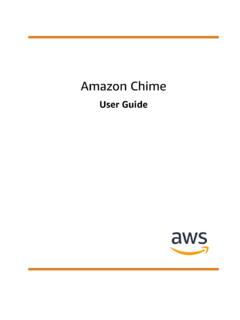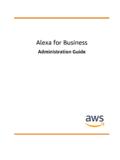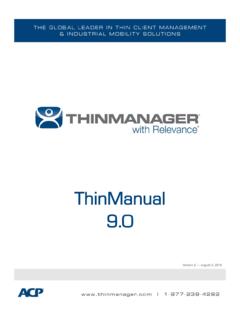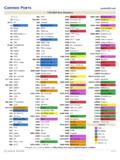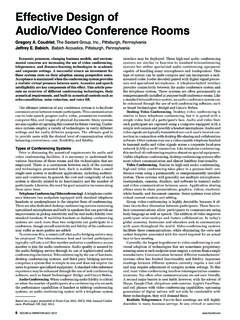Transcription of 1 solaris user - PenguinTutor
1 1 New user To Technical Expert solaris Bookshelf Stewart Watkiss Volume 1 solaris user guide i Copyright All rights to this document are retained by the author Stewart Watkiss. The document is made freely available over the Internet and may be printed for personal use or to pass on to a friend, colleague or family member provided that this copyright message is included in the document. The document however cannot be sold for profit, whether as a computer file, printed document or any other form without written permission of the author. No part of the document may be copied or included into other works without the written permission of the author. Whilst I do not forbid the electronic distribution of this document it is discouraged. Instead please direct them to the web page at where the latest version is referenced. If the document is distributed in electronic format then the following rules must be observed: This message must be included as part of the document.
2 The file must be in its original format without any modification ( the document is provided in Portable Document Format and must be retained in this format). The document may not be divided or sectioned other than how it is when downloaded, the individual parts may be distributed separately however each section must have this copyright message with it. If in doubt about any of the above then you should E-mail the author for clarification. You should also E-mail the author if permission is required to go outside of the rules of these conditions. E-mail If you do not agree with the conditions above then you should immediately destroy any copies (electronic, printed or otherwise) that you may have. I hope you find the document useful. Stewart Watkiss ii 7 iii Contents Preface to Introduction to this Chapter 1 : THE UNIX OPERATING What is an Operating More About The difference with Chapter 2 : GETTING The Logging Directly into a Local Logging in Over a Exiting (logout).
3 13 Important Points for New Chapter 3 : What is a shell?..17 The Various Different The Shell Chapter 4 : COMMANDS AND What are Command and Programs?..23 Command Format of Help with Finding Files and Commands (find)..28 A few useful Chapter 5 : FILES AND What are Files and Directories?..33 iv Relative Special Moving about the directories (cd)..35 Listing the contents of the directories (ls)..36 Referring to files within a Hidden Lost + Chapter 6 : WORKING WITH Making a new directory (mkdir)..43 Making a new file (touch)..43 Removing a directory (rmdir / rm)..43 Removing a file (rm)..44 Moving / Renaming a file or directory (mv)..44 Copying a file (cp)..44 Viewing the contents of a text file (cat)..45 Viewing the beginning / end of a text file (head / tail)..45 Checking the type of file (file)..46 Printing a File Changing File Permissions (chmod).
4 47 Changing the file owner (chown)..49 Chapter 7 : MAKING THE MOST OF UNIX Using command The pipe command (|)..53 Redirecting stdout, stdin and stderr (> <)..54 Chapter 8 : MANAGING YOUR Normal Vs Root Shell .. Chapter 9 : THE VI TEXT Editor Worked Example with Starting Inserting a New v Moving Around the Deleting Letters and Inserting a New Save the Replacing a Search and Save and Command vii Preface to Bookshelf This is the second UNIX book that I ve written. The first is a book on AIX and incorporates the full range of New user to Technical Expert in a single book. The book started out as a aide-m moire as part of my revision towards becoming an AIX Certified Advanced Technical Expert. I passed the exams and continued writing until it took the form of a complete book on the subject.
5 After completing my AIX Certification and Book I set myself a second challenge of applying my acquired UNIX skills to learn solaris . This bookshelf is intended to pass that on to others that may be interested. Rather than writing this as a single book I decided for the bookshelf approach, as it is easier to manage as several smaller books. This was written whilst I had hands on role implementing some new services on solaris . This has given me practical experience of how the operating system can be used and in some areas how it really works as opposed to what the manuals say. viii ix Introduction to this book This book is written for a new user to UNIX. The target audience of this book would typically be someone with little or no experience in UNIX, but maybe a bit of background using other operating systems ( Windows 95/98). All sections are explained in full and therefore no previous experience of any other environments are necessary.
6 The book also includes information on some of the many commands available. It may therefore be useful for someone with previous experience of UNIX. Most of the commands used in this section are the same as used on other UNIX like operating systems such as AIX and Linux. There generally appear to be too different approaches when creating a user guide for a UNIX based computer. One is to explain how to use a graphic interface, explaining what drag and drop means and how to use a mouse, the other explains the commands that allow a user to learn how to operate using a command line. This book is based on the latter; although I do make reference to X-Windows and CDE I am assuming that you do know what a mouse is and how to click on pull down menus. The reason I have gone down this path is that I see the novice solaris user as being someone that will eventually become a system administrator and not someone that will be just clicking mouse buttons all day long.
7 Whilst solaris may provide much of the functionality that is required for running GUI based programs I think that Linux is a more natural choice for the complete beginner who does not have any desire to learn the power of the command line. That is not to say Linux is not suitable for those who prefer the command line, but that it is much more popular as a graphical desktop than solaris . Although solaris does win back users with it s support for high end CAD and Graphics Design applications. Often when people write a separate user guide and system administrators guide they write in an overlap so that you don t have to have both books to understand more about the interaction between a System Administrator and a user . I have not. Providing the books for free means that anyone that has a copy of the user guide can equally obtain a copy of the System Administrators guide and vice-versa.
8 So if something is not explained in the user guide then pick up Volume 2 and you ll probably find it in there. 1 The UNIX Operating System This chapter explains what UNIX is and why you need to know about it. Chapter 1 3 What is an Operating System UNIX is an operating system, that is a layer of software that provides a path for applications to control and communicate with the hardware. Hardware refers to the bit's you can actually see and touch - Disk drives, Monitors, Keyboards, CPU etc. Software refers to programs or pieces of code that make the computer perform a required function. In fact software is what differentiates a computer from other electronic devices. A computer has the ability through using different software to perform different functions. Compare this to an electronic typewriter that is only capable of doing what the hardware is coded to do (type letters directly onto paper).
9 Nowadays it is harder to distinguish the difference as Word Processors can perform the function of a typewriter but can have the ability to do other things, such as transfer the files to a computer or save to disk. Operating Systems are what tie the Software Applications and Hardware together. To explain this a little clearer I'll use an analogy to a taxi. The taxi itself would be the hardware part of the computer, the people travelling in the taxi would be the applications and the taxi driver would be the operating system. Imagine then that you are requested by your boss to attend a meeting at a different location and that you should take a taxi. This would be like a user requesting that an application performs a certain function. You would then request a taxi and get into it. You would not be allowed to drive the taxi yourself so would make a request to the driver (the operating system) to take you to a certain destination.
10 The driver would drive the taxi (control the hardware by using the pedals, steering wheel etc.) to the destination requested by you. Once you reached your destination you would leave the taxi allowing it to transport other people. You can see that this would shield you from having to know how to drive the taxi, you would not need to know whether it was a diesel taxi or a petrol taxi, or whether it was a manual or automatic. All you need to be able to do is to talk with the driver and explain where you wanted to go. In this way if an application needs to write to a disk, it does not need to know the type and size of the disk, it does not need to know how to move the head backwards and forwards. All it needs to do it to send a request to the operating system asking it to write the required data to disk and the operating system will worry about all the details.

